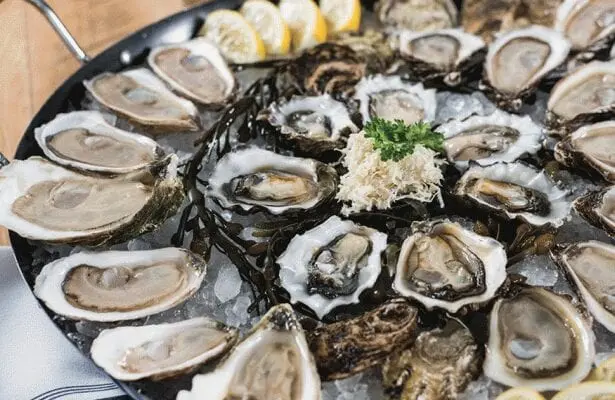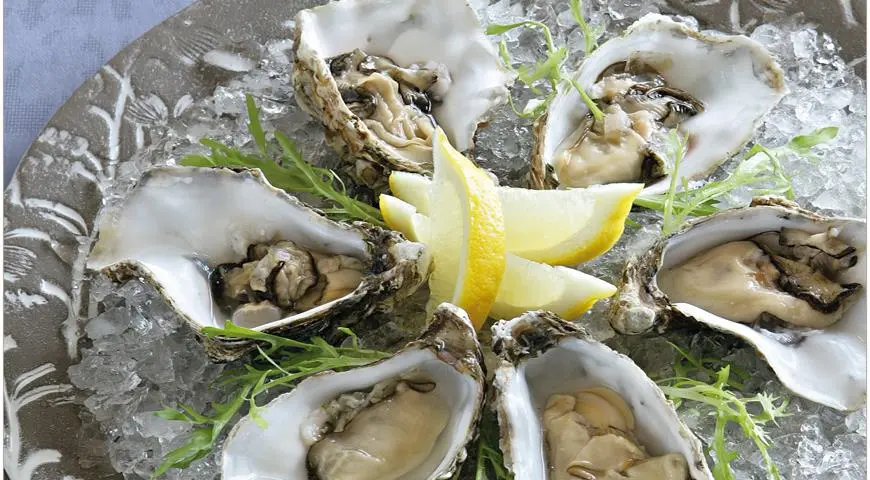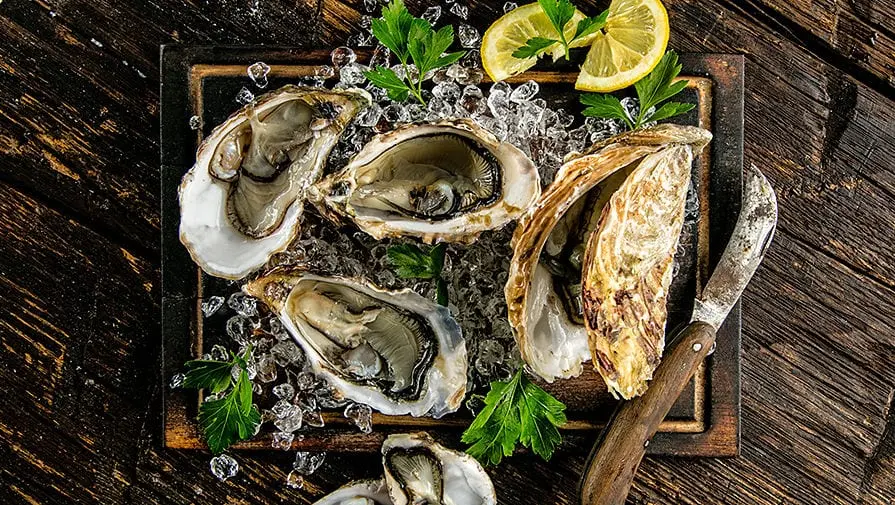Contents
Description
Despite the fact that oysters are used baked, fried, boiled, in fries, in batter or in broth, steamed or grilled, we will talk about the use of oysters fresh, i.e. raw. Since it is in this version that the delicacy raises many questions, mixed feelings, and is so appreciated in an aristocratic society.
This mollusk has become the subject of praise in the works of many famous writers and poets. The French poet Leon-Paul Fargue described oysters as follows: “Eating an oyster is like kissing the sea on the lips.”
The Sea Kiss was the favorite dish of the famous Casanova, who ate 50 oysters for breakfast. It is in this product that they see the secret of his lovingness. Oysters are a widely recognized aphrodisiac.
Poetess Anna Akhmatova also dedicated the lines of her work to this delicacy: “The sea smelled fresh and sharp, Shellfish in ice on a platter …”.
While in France, twenty-five-year-old Coco Chanel learned to eat oysters, then she believed that this was a victory over herself, and later she enjoyed and ranked oysters as one of her favorite dishes that she could not refuse.
Composition and calorie content

This food contains more Iron than 92% of foods. More importantly, although there are several foods (8%) which contain more Iron, this food itself is rich in Iron more than it is in any other nutrient. Similarly it is relatively rich in Zinc, Vitamin B12, Copper and Magnesium
- Caloric content 72 kcal
- Proteins 9 g
- Fat 2 g
- Carbohydrates 4.5 g
The benefits of oysters
The most popular myth about shellfish is that shellfish is said to increase libido. The reason for this is the story that Giacomo Casanova ate 50 oysters every day for breakfast and confidently set off towards love affairs. The fact that Casanova lived in the 18th century, and all his erotic exploits became known thanks to his autobiography, in which he could write anything, does not bother anyone.
True, there was some truth in this. During sexual activity, a man inevitably loses a certain amount of zinc, and the consumption of oysters, in which zinc is found in large quantities, compensates for this lack.
However, oysters should not be considered a pure aphrodisiac either. It’s just that this natural protein is easily and quickly absorbed by the body, a person does not feel sleepy after eating, and he has time and desire to perform active actions, including those of a love nature. And this applies to both men and women.
During Casanova, as you know, stimulating zinc-containing dietary supplements were not released, and the sociable Italian skillfully used the natural gifts of the Mediterranean Sea. So, oysters probably won’t make your personal life worse, but you shouldn’t rely on them as a panacea for love apathy.

But almost all oysters are, first of all, a real pantry of useful vitamins and minerals. They contain magnesium, calcium, potassium, iron, phosphorus, zinc, vitamins A, B, C, E.
Oysters are low in calories, contain only 70 kcal per 100 grams, so they can be consumed without thinking about gaining excess weight. In principle, other seafood has similar beneficial properties – the same shrimp, squid and crabs, as well as most types of wild sea fish, especially white. But oysters have one distinct advantage.
Almost all fish and seafood must be boiled, fried, stewed before use, that is, subjected to heat treatment, in which some part of the necessary trace elements is inevitably lost. Oysters, on the other hand, are eaten raw and actually alive, so all the beneficial properties enter our body without loss. Of course, you can also heat-treat oysters: in Spain and France, for example, they are offered both fried and baked, but this is not for everybody.
Personally, this approach is not to my taste, and I prefer to use oysters, as they say, in their original form.
What happens to the body when you eat oysters
It is not surprising that mainstream medicine recommends eating oysters to lower blood pressure, to restore visual acuity, to maintain healthy skin color, as well as as a prophylaxis against hair loss and even cancer. Women are especially fond of oysters because of the presence of arginine in them, a substance that removes fine lines in the skin and makes hair thicker and thicker.

Oyster harm
However, there is also a fly in the ointment. Oysters should be eaten with caution by allergy sufferers. In addition, there is a risk of buying a poor-quality, or even completely spoiled product, which can lead to severe poisoning. Inexperience, the buyer can, for example, buy oysters with open flaps or purchase already dead oysters.
Types of oysters
At the moment, the highest quality and most valuable are oysters collected from natural reservoirs in Norway. But on sale you can see oysters from many other countries: Japan, France, Ireland, the Netherlands, USA, and many others.
There are about 50 varieties of oysters in nature. They are classified by size, weight, and habitat.
The size of flat oysters is indicated by zeros, the largest size corresponds to 0000. The numbering of concave mollusks is different. From No. 0 to No. 5, where No. 00 is the largest, and with an increase in the number, the size decreases.
By origin, two types of bivalve are distinguished: refined oysters – grown in artificially desalinated water and oysters of the full sea – those that, from birth, live only in the sea.

Oysters are also divided according to the density coefficient. It is understood as the ratio of the weight of the meat of 20 oysters of the same size to the weight of 20 oyster shells, multiplied by one hundred. According to this coefficient, the following types of oysters are distinguished: special, pus-unclair, special de clair, fin, fin de clair.
Fin de Claire oysters are supplied with algae in tanks as additional food. Because of this, they are characterized by the highest fat content, as well as a slight salty aftertaste.
How to open an oyster?
Unlike mussels, you won’t be able to open a fresh oyster with your bare hands. You will also need a small hard steel knife and a special chainmail glove to open it. But in the absence of one, you can use a kitchen towel, you need to protect your hand in case the knife slips. An oyster is taken with the left hand, after putting on a glove or wrapping it with a towel (left-handers, respectively, take it in the right).
The mollusk is placed so that the flat or concave surface of the shell is on top. The knife is inserted into the junction of the flaps and turned like a lever until it clicks. After opening with a knife, it is necessary to cut off the muscle holding the flaps. When opening the oysters, do not turn them over, otherwise juice will leak out of the shell.
If, after opening, shell fragments remain on the oyster, they must be removed with a knife or fork – this must be done, since if they get inside, these fragments can seriously damage the esophagus. The oyster is usually separated from its shell with a special fork with three teeth. Open shells are stacked on ice.
How and with what are oysters served?

Oysters are usually served on a round dish, in the center of which is vinegar, lemon wedges and a special sauce. The sauce can be almost anything: sour, spicy, sweetish, based on olive oil, soy sauce or tobasco sauce, etc. Sometimes croutons and butter are added to the dish.
According to the recommendations of the overwhelming majority of sommeliers, oysters are served with dry white wine or sparkling wine (champagne). The most expressively set off the taste of almost all seafood, fish and shellfish is dry white. Wine should be without a pronounced sharp taste and without too rich bouquet, slightly chilled (10-15 degrees). This wine is able to emphasize the exquisite taste of oysters.
How to eat oysters?
Traditionally, a dozen shellfish are purchased – 12 pieces. It is not recommended to acquire a larger amount, since the stomach can rebel due to such an unusual meal.
The rules for eating oysters are quite simple. Separating the clam from the flaps with a special fork, pour over it with lemon juice or cooked sauce. After that, the shell is brought to the lips, and the contents are sucked out, swallowing without chewing. The contents remaining in the sink are drunk. It should be noted that a fresh oyster will react to lemon juice. She starts to frown a little from him. This is another freshness test.
How to choose and store

Checking oysters for vitality is very simple. When opening a shell with a high-quality live mollusk, a characteristic click should be heard. The oyster itself should smell pleasantly and freshly of the sea, not dead fish, and its flesh should be transparent, not cloudy and whitish. If you sprinkle lemon juice on a live mollusc, you can see its response in the form of a slight twitching in the shell.
At home, oysters can be stored in the refrigerator for no more than 6 hours; it is also not recommended to freeze them, since they will inevitably lose some of their useful properties.









